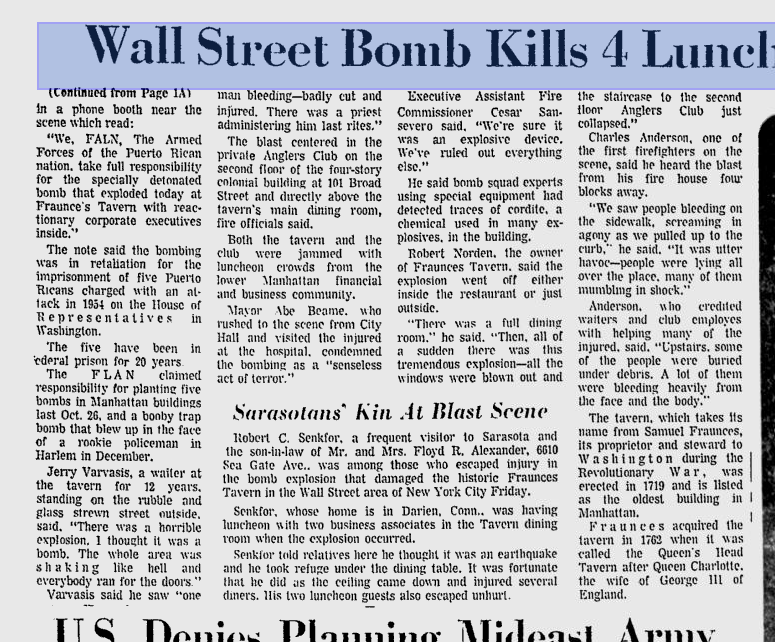Inside the Angler’s Club of New York, Part 2
When I posted a few months ago about the Angler’s Club of New York, I neglected to tell one important anecdote that was relayed to me.
Now that Sandy’s left much of the New York City area underwater, the Angler’s Club’s fate seems like it would be uncertain. Fraunces Tavern, on the corner of Broad and Pearl streets, remains closed indefinitely. I would imagine the Angler’s Club, on the second floor, would be better off, but I haven’t been able to find any news of the relics inside, and the huge mass of books and papers and interesting lore it holds. Certainly, the old foundation of the building will be put to the test.
This isn’t the Angler’s Club’s first brush with a destructive fate, though. In 1975 the FALN, a terrorist group of Puerto Rican nationalists, attempted to plant a bomb in the tavern. They bombed the Angler’s Club instead. Four people eating lunch died in the attack. The article from the Sarasota Herald Tribune below has more.
In the rubble of that explosion, later, as club members were picking through, they found a letter to Theodore Gordon (below, full text in the Fly Fisher’s Reader, with more at Classic Trout) and accompanying flies in a trash heap, ready to be thrown away. It’s from Frederic Halford, and includes a number of flies used in British trout fishing. Gordon went on to adapt those patterns to the waters around New York, and many of the flies we tie today are based on them.
If this diamond could be rescued and restored, hopefully the same spirit will keep the Angler’s Club of New York bouyant through this hard time.
35 Inverness Terrace Hyde Park W February 22, 1890
Dear Sir: You must excuse my delay in replying to your favour of the 15th ult. I can quite imagine that in some parts of your country fish could be taken with dry fly where the more usual sunk fly would be of no avail–my difficulty however as to advising you of patterns likely to be successful is chiefly due to the fact that I have no knowledge of the streams or lakes nor of the genera and species of natural fly prevalent in them–hence I have thought it better to send you a few of the flies I use myself as patterns rather than order here what might prove after all useless to you–knowing your own rivers you can then select the patterns which seem likely and dress them yourself or order in the U.S.–if you prefer to have them dressed here and want my advice as to the best dresser I should recommend you giving your order to Mr. G. Holland–Bridge Street–Salisbury. If you tell him that the patterns were dressed for and by me and give the name he would be able to send you exactly what you wanted–in all case however give him the size of the hook and to assist you in this I have enclosed a set of the original size from 000 to 4. (Edit.–English system.) The shape of the hooks now made by Hutchison are to my mind an improvement on the original one as designed by my friend Mr. Hall–being more hackle only. If you should be unsuccessful with the floating flies or in doubt as to patterns please try and collect a few of the natural insects in sprit and send them to me by post and if I can dress imitations I will–a tube about 3” x 1” corked, quite full of methylated spirit packed with cotton wool in a small block of wood bored out to receive the tube will travel all over the world by post–of course the color does fade to a certain degree even in spirit but from experience I think I could allow for this and possibly even might know the genera and species– If I can be of any further assistance to you pray write and in any case kindly let me know the result of your experiments– With kind regards, Yours faithfully FREDERIC M. HALFORD THEODORE GORDON, ESQ.
Newspaper article on the Angler’s Club of New York bombing] 